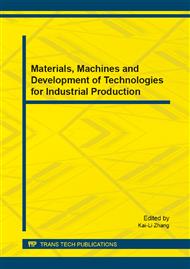p.86
p.90
p.94
p.100
p.105
p.109
p.114
p.120
p.125
Preparation and Coating Properties of Silicone/Cuprous Modified Acrylic Resin
Abstract:
The modified resins, as antibacterial coating materials, have attracted wide attention. Two steps to obtain resins: cuprous oxide collosol particle was prepared by reduction of Copper acetate solution, using hydrazine as the reducing agent, then oleic acid was added to the system as the covered agent; silicone and cuprous modified acrylic resin was successfully synthesized by solution polymerization with the monomers of acrylic acid (AA), butyl acrylate (BA), methyl methacrylate (MMA), vinyl triethoxy silane (VTES) and the as-prepared oleic acid coated Cu2O sol, using the azobisisobutyronitrile (AIBN) as the initiator. The samples were characterized by X-ray Photoelectron Spectroscopy (XPS) and FTIR analysis. The effects of silicone content on the properties of polymer coatings were investigated by contact angle analysis.
Info:
Periodical:
Pages:
105-108
Citation:
Online since:
August 2014
Authors:
Price:
Сopyright:
© 2014 Trans Tech Publications Ltd. All Rights Reserved
Share:
Citation:


